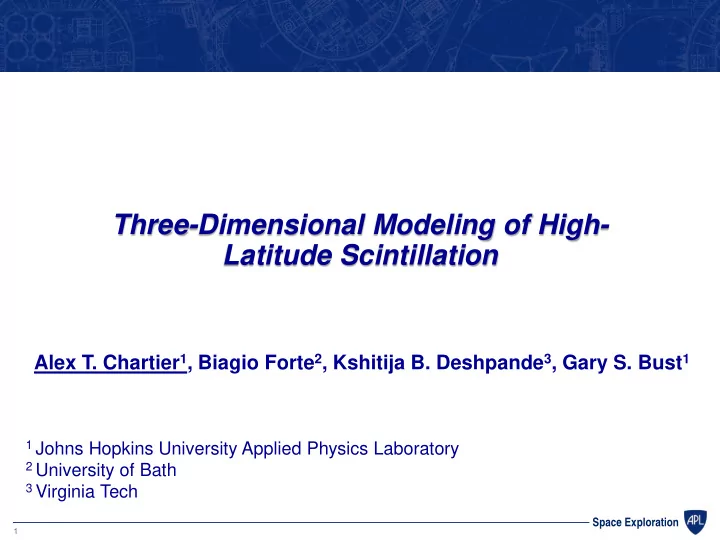

Three-Dimensional Modeling of High- Latitude Scintillation Alex T. Chartier 1 , Biagio Forte 2 , Kshitija B. Deshpande 3 , Gary S. Bust 1 1 Johns Hopkins University Applied Physics Laboratory 2 University of Bath 3 Virginia Tech Space Exploration
Outline Observations Modeling Conclusions Space Exploration
Observations Electron density profiles: EISCAT ISR Tromso Small-scale structures: 50hz GPS receiver Tromso Aurora: All-sky camera Ramfjordmoen (just south of Tromso) Field-aligned currents: SuperMAG Magnetosphere: THEMIS satellites Space Exploration
Date: 17 October 2013, Observations Time: 18:00 – 21:00 UT Radar Location Space Exploration
Date: 17 October 2013, Observations Time: 18:00 – 21:00 UT EISCAT tracks GPS satellite ( PRN 23 ) Radar Location Beam Direction Space Exploration
Observations: EISCAT Space Exploration
Observations: EISCAT Space Exploration
Observations: EISCAT + 50hz GPS Space Exploration
Tromso all-sky camera STELab Nagoya University Space Exploration
Tromso all-sky camera STELab Nagoya University Space Exploration
Tromso all-sky camera STELab Nagoya University Poleward expansion Space Exploration
Tromso all-sky camera STELab Nagoya University Poleward expansion Space Exploration
Space Exploration
Space Exploration
Westward Flow Space Exploration
Westward Flow Space Exploration
Westward Flow Space Exploration
Westward Flow Space Exploration
Themis satellite locations 20:05 UT ~8 earth radii Space Exploration
Themis 100 km footprints 20:05 UT Space Exploration
THEMIS P4 Electron Precipitation ~20:04 UT 24:00 UT 22:00 UT 18:00 UT 20:00 UT Space Exploration
THEMIS P4 Electrostatic analyzer Search coil magnetometer 10 keV electron precipitation EISCAT Time (UT) Solomon [2001] Space Exploration
Modeling 3D multiple phase screen signal propagation [ Rino, 1979]. 60 phase screens, 5 x 5 x 400 km volume 2 km cross-track gradient. 330 m/s drifts Thick, anisotropic ionospheric irregularity layer [ Costa & Kelley, 1977] • Axial ratio: 5 • Spectral index: 3 • Outer scale: 5 km SIGMA model implemented by Deshpande et al. [2014], geometry modified here Space Exploration
Modeling GPS signal GPS receiver Space Exploration
Modeling Refraction Space Exploration
Modeling Refraction Diffraction Space Exploration
Parameter Value Modeling Cross-track velocity 330 m/s Gradient size 2 km Irregularities None Sample rate 10 Hz EISCAT Observed Refractive 18 seconds Model Space Exploration
Parameter Value Modeling Cross-track velocity 330 m/s Gradient size 2 km Irregularities 0.5 % Sample rate 10 Hz EISCAT Observed Refractive + 18 seconds Diffractive Model Space Exploration
Summary Substorm onset identified using GPS scintillation Three-dimensional modeling approach developed Refractive effects shown to be important Space Exploration
References Costa, E., & Kelley, M. C. (1977). Ionospheric scintillation calculations based on in situ irregularity spectra. Radio Science , 12 (5), 797-809. Deshpande, K. B., Bust, G. S., Clauer, C. R., Rino, C. L., & Carrano, C. S. (2014). Satellite ‐ beacon Ionospheric ‐ scintillation Global Model of the upper Atmosphere (SIGMA) I: High ‐ latitude sensitivity study of the model parameters. Journal of Geophysical Research: Space Physics , 119 (5), 4026-4043. Rino, C. L. (1979). A power law phase screen model for ionospheric scintillation: 1. Weak scatter. Radio Science , 14 (6), 1135-1145. Solomon, S. C. (2001), Auroral particle transport using Monte Carlo and hybrid methods, J. Geophys. Res., 106(A1), 107–116, doi:10.1029/2000JA002011. Space Exploration
SuperDARN Space Exploration
SuperDARN Space Exploration
SuperDARN Space Exploration
TEC modeling Space Exploration
Recommend
More recommend